Maverick, Tremor bridge Ford truck span
By John Gilbert
All attempts to chronicle the truck war going on in the industry need to be agile just to keep up with the lively and extremely competitive vehicles being turned out in all shapes and sizes. The battle includes heavy-duty, standard full-size, compact, and niche vehicles that fill in the blanks.
As might be expected, Ram, Chevy, GMC, Toyota, Nissan, Honda, and even newcomer Hyundai are in the battle, but when you evaluate fully, you have to start with Ford. The standard of the truck business remains the Ford F150, which, on its own, comes in assorted sizes and powertrains with two or four doors of assorted sizes. My favorite is the Raptor, built for heavy off-road domination, but today we get to check out the Tremor, which is a compromise model between the Raptor and the normal truck.
I’ve written about the oversized F250 Tremor which seems capable of conquering just about any challenge, and also the compact Ranger, which comes in Tremor trim. Now we get a chance to try the Tremor application on the standard-issue F150 — the leading seller among all vehicles for somewhere north of 30 years.
But impressive as all that power is from the 3.5-liter twin-turbochaged V6, what in the name of $6-a-gallon gasoline is going on here?
Ford is taking all that into account, and while I’ve test-driven a couple of Ford’s new more-compact Maverick vehicles and come away thoroughly impressed, I’ve also driven the F150 with hybrid technology, and it is the best thing to happen to big pickups until we get to the all-electrics that are fast-approaching.
The Maverick seems to be just as big as the midsize Ranger, but it isn’t. It’s considerably shorter, but it is wide enough to carry four or five occupants with plenty of room, and its 2.5-liter 4-cylinder turbo has plenty of punch to send the Maverick on its way — with good reason. This particular Maverick engine had the electric support from being a hybrid.
Ford has led the way among U.S. manufacturers in building some impressive hybrid powertrains, what the industry calls “mild” hybrids for the way the battery-operated electric motor both supplements the gas engine and allows it to deliver much-improved gas mileage and doses of extra power. The Maverick Hybrid does both of those things.
A couple days after the first Maverick was delivered out of the Chicago press fleet, we got one of our heavy snowfalls in the Duluth, Minnesota, area of the North Shore. I was less than thrilled that the Maverick, painted a beautiful dark blue called “Alto Blue Metallic” was 2-wheel-drive. The second Maverick I tested was bright red, and looked upper-level, although it was pretty basic. In the surge of truck buying in our society, I can understand getting a front-engine, rear-drive pickup down on the southwestern prairies, but if you’re sending a pickup truck to the North Shore of Lake Superior in mid-to-late winter, send 4-wheel drive or nothing.
The Maverick was front-wheel drive, which made it an interesting compromise. I picked my spots during the snowy week, and we made it through OK, but we weren’t hauling stuff in the bed, although we were spending inordinate time warming up the Maverick against some below-zero temperatures. The remote start gadget was greatly appreciated, although the lack of heated seats or heated steering wheel was less impressive, when it was 15 below zero. That was why we spent so much time warming up the Maverick.
Because of so much warm-up time, we didn’t approach the high mileage we anticipated, but later in the week, we did spend time driving and focusing on hybrid driving techniques — slowing down ahead of red lights, avoiding jack-rabbit starts, etc. — we did get it up to a computer-registered 30.8 miles per gallon over a 142-mile stretch. Any pickup truck that can do pickup duties and deliver 30 miles per gallon can make a big impact on the marketplace as gas prices continue to soar.
The Maverick Lariat 4×2 had a sticker price of $29,340 with the automatic continuously variable transmission and the 2.5-turbo-hybrid powertrain, which made a solid combination.
Maybe in the future, two-vehicle families who love their pickup trucks can compromise and get a hybrid Maverick-sized compact pickup, and still satisfy their power cravings by adding the big F150 Tremor to the stable.
This F150 came in stone gray metallic, which set off the bright orange graphics that were subtle and not overwhelming, but looked good with the color and the blacked-out wheels and grille. This thing had 4-wheel drive and a 10-speed automatic transmission to distribute the power from the 3.5-liter twin-turbo V6 to all four extremities.
The base price of the F150 Tremor is a reasonable $49,505, although it becomes increasingly less reasonable — unless you have to feed your appetite for various options — as you add the impressive features on the way to the test truck’s $70,095.
Snow didn’t matter with this thing, and its force and stability were much appreciated. The appeal of the option list included a trailer-towing package, lockable storage areas in the bed’s wheel wells, a power tailgate, a front-axle torsion differential, and a “Toughbed” Bedliner. The full crew cab, which Ford calls Super Cab, had enormous room, and flip-up storage under the rear seat, a feature the Maverick has picked up on.
The F150 Tremor also has a few Ford-first things, such as the tailgate, which is only now being copied by General Motors after Ford introduced it over a decade ago. The new truck adds a power operation to it. At the top of the tailgate, there is a form-fitted hand grip that means when you lower the tailgate you also unfold a secondary step that drops down, and next to the grip is a small knob that you pull out to reveal a heavy rail, which you can fold up until it clicks into place to give you a sturdy grip to aid in climbing up into the bed to make sure your stashed goodies are still secured. Climb down to go back to driving and you fold the stability pole down and slide it back into place, flip up the step, and use the power gadget to return the tailgate to its original position.
Another thing that makes the plush interior even more impressive to ride in is the B&O “Unleashed” 18-speaker audio system that fills the cab with sound from whatever device you choose to listen to. And, if you want to work while your wife spends an hour in Target, you can fold the gear shift lever flat into the console, then lift the console cover and fold it down to make a flat, desk-like surface. The rest of the console is for storing business sheafs or whatever you choose.
Our older son, Jack, rode with us a few times in the Tremor and commented on how remarkably smooth the ride was in the big Ford over winter-ravaged surfaces. We found Ford’s better idea was to not go to the 20 or 21-inch wheels popular on some trucks and SUVs, but instead to use smaller 16-inch alloy wheels with much larger and thicker tires, meaning that to attain the same circumference, you have less alloy and more inches of rubber between you and the potholes you’re lumbering over. The thicker rubber absorbs the impacts much better and makes you appreciate the level of comfort.
Not only that, but the Tremor also had electric seat-heaters and a steering wheel heater, which is worth plenty on those cold, winter mornings when autostart is a greater benefit with the supporting devices.


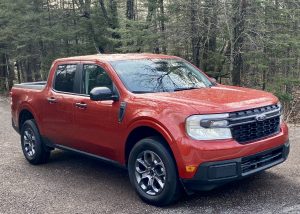
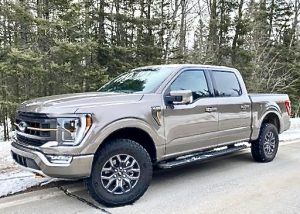
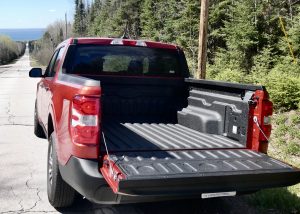
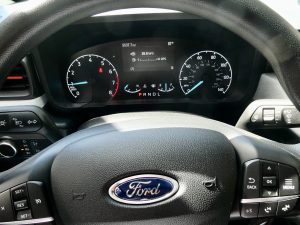
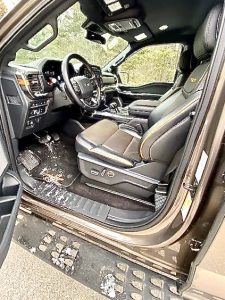
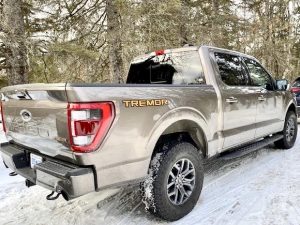
 John Gilbert is a lifetime Minnesotan and career journalist, specializing in cars and sports during and since spending 30 years at the Minneapolis Tribune, now the Star Tribune. More recently, he has continued translating the high-tech world of autos and sharing his passionate insights as a freelance writer/photographer/broadcaster. A member of the prestigious North American Car and Truck of the Year jury since 1993. John can be heard Monday-Friday from 9-11am on 610 KDAL(www.kdal610.com) on the "John Gilbert Show," and writes a column in the Duluth Reader.
John Gilbert is a lifetime Minnesotan and career journalist, specializing in cars and sports during and since spending 30 years at the Minneapolis Tribune, now the Star Tribune. More recently, he has continued translating the high-tech world of autos and sharing his passionate insights as a freelance writer/photographer/broadcaster. A member of the prestigious North American Car and Truck of the Year jury since 1993. John can be heard Monday-Friday from 9-11am on 610 KDAL(www.kdal610.com) on the "John Gilbert Show," and writes a column in the Duluth Reader.